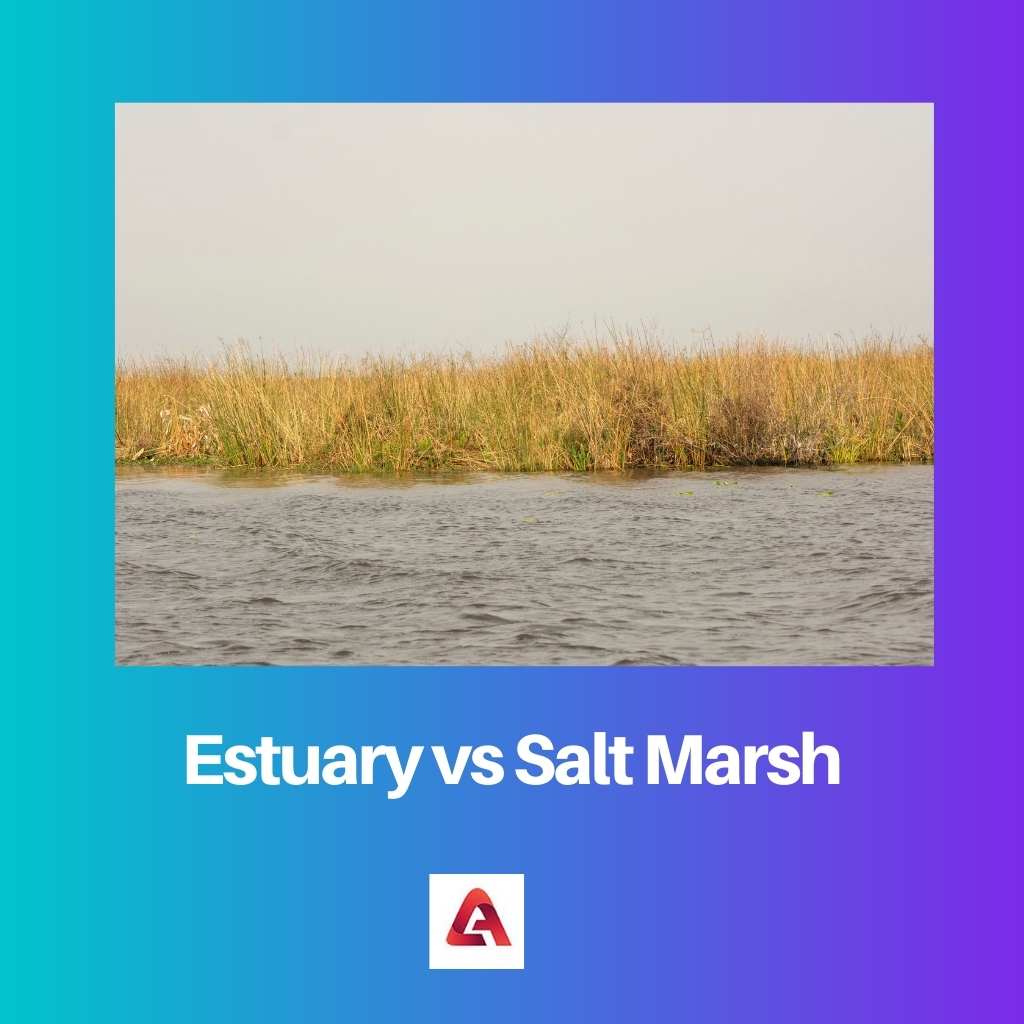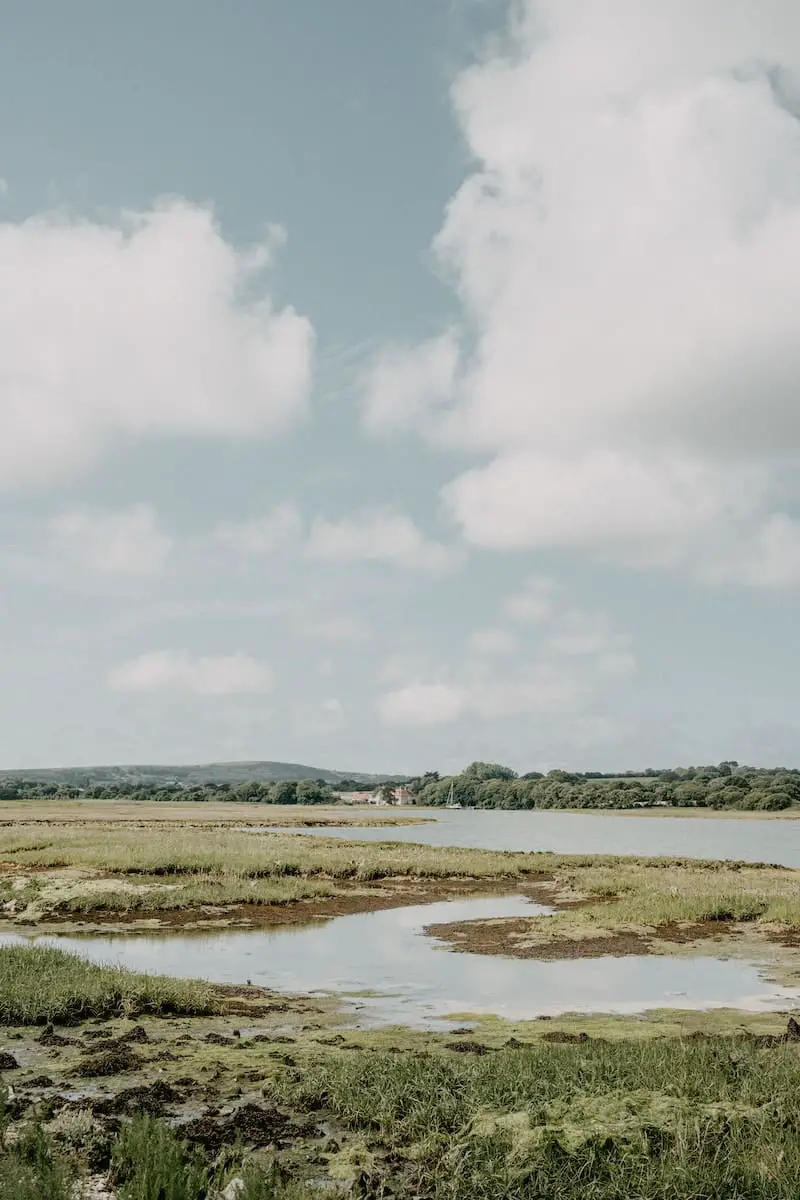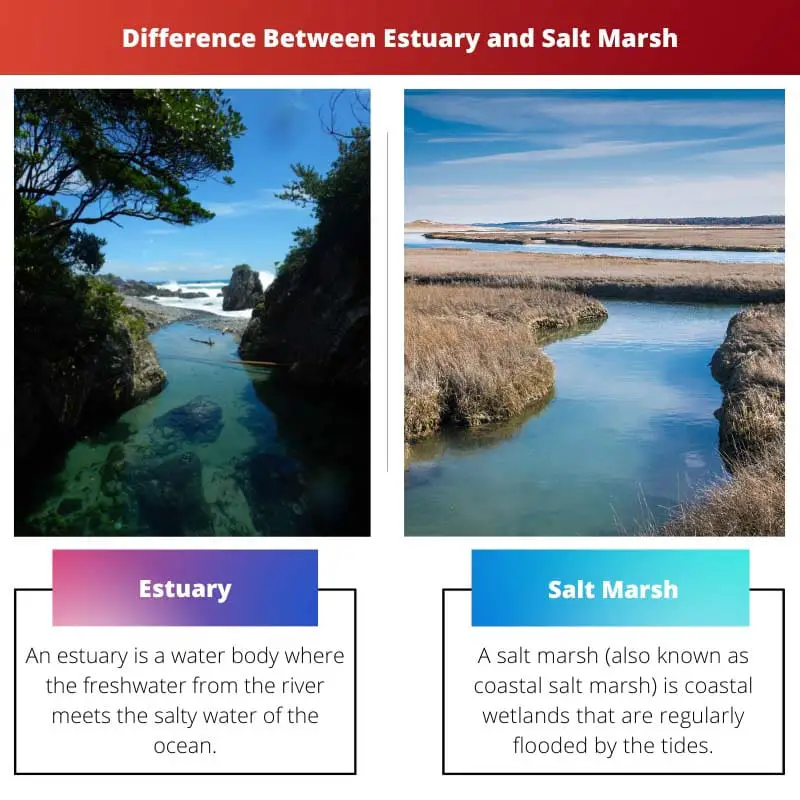Estuaries and salt marshes form very unique ecosystems as various kinds of flora and fauna thrive in these areas. Various migratory fishes also cross several estuaries when they migrate during various seasons.
These areas are very good spots for fishing or catching various crabs and other sea animals that have high demand in the food industry.
Key Takeaways
- Estuary is a partially enclosed body of water where freshwater from rivers mixes with saltwater from the ocean. In contrast, a salt marsh is a marshy area flooded by seawater during high tide.
- Estuaries are more productive and diverse ecosystems than salt marshes, supporting various aquatic and marine life. In contrast, salt marshes are home to a unique community of plants and animals adapted to living in brackish water.
- Estuaries are more affected by human activities such as pollution, overfishing, and habitat destruction than salt marshes.
Estuary vs Salt Marsh
An estuary is a partially enclosed coastal body of water where saltwater from the ocean mixes with freshwater from rivers and streams. It’s important for many fish and shellfish species. A salt marsh is a coastal wetland that is characterized by the presence of salt-tolerant grasses and other vegetation. Provide habitat for a variety of fish and bird species.

As much as estuaries are very rich ecosystems for varieties of plants and animals, it supports human life in many ways as well. Living near an estuary gives people the advantage of having fresh drinking water from the river and the ocean provides a great source of communication, especially for trading.
Salt marshes are low and flat ground that is daily or occasionally flooded by the tides. The water current here brings either salty or brackish water with a lot of sediments.
There is a thick layer of grass and grass-like plants that cover the base of a salt marsh. Plants growing here are adopted to an extreme saline environment.
Comparison Table
| Parameters of Comparison | Estuary | Salt Marsh |
|---|---|---|
| Definition | An estuary is a water body where the freshwater from the river meets the salty water of the ocean. | A salt marsh (also known as coastal salt marsh) is coastal wetlands that are regularly flooded by the tides. |
| Formation | Estuaries were mainly formed when the sea level increase at a rapid speed and formed traps for sediments and similar materials. | A salt marsh forms in coastal areas where the tides or water currents deposits sediments. They are no strong waves in these areas. |
| Flora | Red algae are a common flora that grows in an estuary. | Smooth cordgrass is very common to the salt marsh ecosystem as its well-anchored roots prevent erosion. |
| Fauna | Some animals that can survive in an estuary are fish, shrimp, shellfish, squid, etc. | Various kinds of crabs are very common in salat marshes. |
| Land/Water | An estuary is mainly a water body and there is no partial fraction of land on it. | It is mainly coastal grassland that is flooded by water. |
| Geography | Lawrence River is the largest estuary of the world that connects the Great Lakes to the Atlantic Ocean. | One of the largest salt marshes in the world is the Scarborough Marsh located in Southern Maine. |
What is Estuary?
The formation of an estuary gives rise to a water body with brackish water. It is slightly salty water but not too salty as the ocean water. Brackish water has a very unique ecosystem as several kinds of aquatic flora and fauna thrive in it.
Since an estuary doesn’t have any solid boundary around itself, water is continuously flowing in that area. During the tides, a large amount of ocean water enters the area.
During the high tides, estuarian currents are formed which are heavier because of the seawater and they tend to sink and move at the bottom of the estuary.
The change in the salinity and water level in an estuary change with the high and low tide. Its behavior also changes with the season. For example, in the rainy season, more fresh water from the river enters the estuary whereas in the dry season it becomes more saline.
There are a total of four categories of estuaries. They are coastal estuaries, tectonic estuaries, bar-built estuaries, and fjord estuaries.
Many floras and fauna thrive in estuaries because they are rich in plankton and bacteria. Moreover, the decomposing plants also provide a very rich source of nutrients for the animals. During ancient times, civilizations were also built around estuaries.

What is Salt Marsh?
The soil texture in a salt marsh is very marshy because of the presence of deep mud and peat. The peat offers a very thick layer of soil because it is formed by decaying plant matter. Since the texture of the peat is very spongy, similar behavior is exhibited by the salt marshes.
Though the decomposing plant matter offers a very rich source of food for the fauna that grows in the salt marshes, peat can have an extremely low level of oxygen. This condition is called hypoxia where the bacteria produce a very unhealthy odor common to the marshes.
Salt marshes are mainly found along the protected shorelines and they are very common in the US. Salt marshes are a very good source of earning as well because, along the coastline, fishery business thrives and the communication link is also good.
Apart from the fishes, there are shrimps and various types of crabs thriving in this habitat.
Salt marshes also have natural benefits as they protect the shorelines from erosion. Due to the intertidal activities and trapping of the sediments, the possibility of erosions is reduced in these areas.
During heavy storms, they can absorb the rapid influx of water and prevent severe flooding.

Main Differences Between Estuary and Salt Marsh
- An estuary is a water body where the river meets an ocean whereas a salt marsh is coastal wetlands that are regularly flooded by the tides.
- Estuaries were mainly formed when the sea level increase at a rapid speed and formed traps for sediments whereas a salt marsh is formed in coastal areas where the tides or water currents deposits sediments.
- Red algae are the most common flora in an estuary whereas smooth cordgrass is the most common fauna in a salt marsh.
- There are several types of fish in an estuary whereas there are several types of crabs in a salt marsh.
- Estuary is mainly a water body whereas salt marshes are mainly coastal grasslands.

- https://www.science.org/doi/abs/10.1126/science.147.3653.50
- https://onlinelibrary.wiley.com/doi/abs/10.1111/j.1747-6593.2010.00243.x
